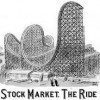Brace yourself! The stock market is ripe for a nasty selloff according to a number of  politicians and even more market pundits – but not so fast. Two very reliable long-term recession indicators strongly suggest that a correction – or worse, the end of the bull market – is highly unlikely given the current state of the economy. Let me explain.
politicians and even more market pundits – but not so fast. Two very reliable long-term recession indicators strongly suggest that a correction – or worse, the end of the bull market – is highly unlikely given the current state of the economy. Let me explain.
The above introductory comments are edited excerpts from an article* by (wallstreetdaily.com) entitled Is It Time to Call Wall Street’s Bluff?
The following article is presented courtesy of Lorimer Wilson, editor of www.munKNEE.com (Your Key to Making Money!), and www.FinancialArticleSummariesToday.com (A site for sore eyes and inquisitive minds) and has been edited, abridged and/or reformatted (some sub-titles and bold/italics emphases) for the sake of clarity and brevity to ensure a fast and easy read. This paragraph must be included in any article re-posting to avoid copyright infringement.
Basenese goes on to say in further edited excerpts:
Brace yourself! The stock market is ripe for a nasty selloff. The signs are so ubiquitous – and so obvious – that even retired politicos can sense the impending doom. In fact, they’ve graciously taken to the media to warn us helpless retail investors.
- Retired Fed Chairman, Alan Greenspan, told Bloomberg that a “significant correction” lies ahead.
- Former U.S. Representative, Ron Paul, insists that “the conditions are every bit as bad as they were in ’08 and ’09.” (Scared yet?)
- Ex-Reagan adviser, David Stockman, swears that “the implosion is near.”
Politicians aren’t alone, either. The financial punditry keeps ushering in alarming data points to scare us stockless, too.
- Over at Yahoo! Finance, a headline claims that the “big money” is dumping stocks. Institutions yanked a collective $7.97 billion out of equity ETFs last week. That’s the largest outflow since February, after which the Dow suffered a 5% pullback.
- Then there’s The Wall Street Journal’s Chris Dieterich. He reports that “the pile of bearish options bets is growing larger by the day.” They outnumber bullish bets by a huge margin, and we’ve only witnessed such extreme negativity twice before in the past two decades. And in both instances, the lopsidedness preceded major market corrections.
In other words, we’re doomed, right? Not so fast.
No Corrections Without Recessions
I agree with Josh Brown, CEO of Ritholtz Wealth Management, when he says, “I’d rather pound a nail through my hand than try to guess when the next correction will be.”
Indeed! Besides, we have concrete evidence that now is not the time to give in to the fearmongering.The S&P 500 has currently gone 1,030 days without a 10% correction. Impressive, yes, but history indicates that the streak could extend much longer.
- From 1990 through 1997, the S&P 500 went 2,573 days without a 10% drop and
- from 2003 through 2007, the S&P 500 went 1,833 days before buckling.
Sure, a correction is inevitable – eventually – yet it’s impossible to know when with any certainty. Here’s what I do know with certainty, though.
- Over-enthusiasm historically precedes market corrections or prolonged downturns and, right now, we’re witnessing the exact opposite.The masses are fearful and, as Warren Buffett advises, that means we should be greedy.
- Contrarian wisdom aside, it’s important to also recognize that bull markets historically end when recessions begin.
Two Timely Recession Indicators
The two most reliable long-term recession indicators couldn’t be flashing a clearer signal:
- Economist Jeremy Piger’s Recession Probability Index tracks four monthly variables used by the National Bureau of Economic Research (NBER), the official organization tasked with declaring recessions.
- The time to get scared is when the probability spikes…above 80% for three consecutive months [which, historically,] have been a telltale sign of an impending recession.
- The current reading checks in at a mere 0.92%.

- Another trustworthy recession indicator is the 2/10 Spread – or the difference between interest rates on 10-year U.S. Treasuries and 2-year U.S. Treasuries. It’s based on market (not government) data, for all you conspiracy theorists out there who are reluctant to embrace Piger’s Index.
- The time to freak out is when the 2/10 Spread goes negative. Such dips historically precede recessions.
 Granted, the spread is narrowing, but the current reading of 193 basis points is nowhere close to the danger zone, either.
Granted, the spread is narrowing, but the current reading of 193 basis points is nowhere close to the danger zone, either.
Bottom line:
A correction – or worse, the end of the bull market – is highly unlikely, given the current state of the economy. This week’s stronger-than-expected GDP report, combined with five months of employment growth of 200,000 jobs or more, points to an economy that’s accelerating, not downshifting.
Ignore the politicians doling out investment advice. It’s time to call the “smart money’s” bluff and stay invested.
Ahead of the tape,
Louis Basenese
Editor’s Note: The author’s views and conclusions in the above article are unaltered and no personal comments have been included to maintain the integrity of the original post. Furthermore, the views, conclusions and any recommendations offered in this article are not to be construed as an endorsement of such by the editor.
*http://www.wallstreetdaily.com/2014/08/01/ceo-self-mutilation-protest/ (© 2014 Wall Street Daily, LLC. All rights reserved.)
Follow the munKNEE!
- Register for our Newsletter (sample here)
- Find us on Facebook
- Follow us on Twitter (#munknee)
Related Articles:
1. Stock Market Bubble to “POP” and Cause Global Depression
In their infinite wisdom the Fed thinks they have rescued the economy by inflating asset prices and creating a so called “wealth affect”. In reality they have created the conditions for the next Great Depression and now it’s just a matter of time…[until] the forces of regression collapse this parabolic structure. When they do it will drag the global economy into the next depression. Let me explain further. Read More »
2. No Recession Until These 6 Indicators Are Triggered
Despite a long list of major risks to the global economy, the trend for the stock market is still UP until proven otherwise. At this stage it is absolutely critical to be cautious and watch for signs of a market correction or peak, but it is our view that a recession won’t take hold until the following 6 key indicators are triggered. Read More »
3. All Is NOT Hunky Dory In the Stock Market – Here’s Why
We look at this market and we see “too much.” Too much divergence, too much complacency, too much embedded downside risk…the list goes on and covers many things. Let’s make the rounds and see what we find [and what it means for the immediate well-being of the various stock markets.] Read More »
4. Mixed Signals About Direction of Stock Market Abound – Here Are 10
[No wonder you are confused!] Several technical and fundamental indicators have flashed caution to no avail and this has given way to an uncomfortable tension beneath the surface as investors try to find answers while keeping pace with performance. Below are 10 mixed signals about the near-term direction and theme of the markets. Read More »5. Risk Aversion Has Run Its Course. What Are the Implications for the U.S. Economy Going Forward?
With QE now winding down, the economy facing reduced headwinds, and risk aversion beginning to decline, risk taking is beginning to increase and that is an essential ingredient for healthier economic growth. Read More »
6. Bubble-level Valuations Don’t Cause Bear Markets! These Factors Do
So much analysis we see and hear lately is concerned with whether the stock market is in a bubble or not. The truth of the matter, however, is that bear markets do not begin due to bubble-level valuations being reached and then bursting, but in anticipation of half a dozen mitigating factors as outlined in this article. Read More »
7. What Are the 2 Catalysts That Cause Major Market Corrections Telling Us Today?
There are a number of potential pitfalls out there for the market but, right now, the behavior of the main catalysts for a major correction suggest that there continues to be more right than wrong with the market. Let me explain. Read More »
8. What’s the Best Way to Invest Given Today’s Disturbing World News Headlines?
It’s hard not to see some disconnect between recent disturbing world news headlines and the market’s quiet advance but this disconnect is rational in the short term, but not necessarily in the long term. Here are 3 rules of thumb for how investors can potentially respond. Read More »
9. Bigger IS Better! What Does This Selective Advance Mean For the Stock Markets Going Forward?
The average U.S. stock is DOWN over 1% thus far in 2014. How can that be when we’re being told almost daily that the Dow and S&P 500 are hitting new all-time highs? The answer is likely to surprise you. Read More »
10. Remember the “Nifty 50″? It’s Back! What Does It Mean For the Markets Going Forward?
Market historians will recall the term “Nifty 50” originated in the 1960’s bull market to describe 50 wildly popular large-cap stocks at the time. Interestingly, some of the same names from that list are leading the market higher today. The question for investors, of course, is what this selective advance means for the markets going forward. Read More
 munKNEE.com Your Key to Making Money
munKNEE.com Your Key to Making Money


